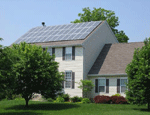
The benefits of solar power have long been espoused by environmentally friendly activists, eager to coerce more people into using solar panels in lieu of electricity. They state that solar energy will protect the planet for decades to come with owners of such units imbued with a calm that comes from knowing they have done the right thing. However, financial realities still rules the hearts and minds of the general public. Going green is one thing but having enough money to get by is quite another. The bottom line is: How much does it actually cost to install these eco-friendly solar panels?
While it would be wonderful if we could answer this question quickly and succinctly, alas it is impossible. In an ideal world, there would be a standard price for the solar panels and installation and that would be it. However, this is not taking into account tax rebates (more on that later), cost of maintenance and eventual energy savings.
Cost Of Panels
We will cover the costs of the basic materials first. If you have the skill to install your own solar panels, they will probably cost less than $3 a panel. However, you then have to circumnavigate a number of issues. It is better for the vast majority of the population to pay for installation which changes the price to between $5 and $9 per panel depending on the organization you use.
Trying to discover how much the whole system will cost is not easy. For a start, you will need to find out how much energy your home is using per year. Chances are, you are using far too much. It is hoped that solar energy will not only reduce pollution, it will also cause families from all over the world to be more conservative with their energy usage. Electricity companies charge you by the Kilowatt Hour (kWh). A kWh is defined as 1000 watts used for an hour. For example, if you use 500 watts for an hour, you are said to have used 0.5 kWh.
Tax Rebates
Extensive research has shown that the average American home uses approximately 920 kWh per month. Confusingly, the net cost for purchase and installation of solar panels ranges from approximately $3,000 to almost $80,000. Why? Because there is also the issue of tax rebates. Certain states in America offer tax rebates which vary. For example, Arizona offers a tax rebate of between $2.50 and $3 per watt while residents of Austin, Texas are given a rebate of $4.50 per watt. There is also the new 30% Federal Tax Break which has been recently introduced. Below is a comprehensive table with two examples using the states of Texas and Arizona to give you the cost of installing solar energy panels in these states. Bear in mind that the cost of installation depends on the following factors:
- How much energy you use a month
- What % of your energy usage do you want solar energy to cover? (It is possible to purchase a system that covers anywhere from 10-100% of your energy usage)
- Energy generated per 1 kWp of the system (The more sun your area gets, the more efficient the system will be)
- Rate of installation
- Tax Rebate
- System size required
- Federal tax credit
Hopefully, the above figures will convince you that there is no straightforward answer to the question of how much it costs to install solar panels. Certainly, if you live in a state where there are high tax rebates and Federal tax credit, solar panels are exceptionally cheap. In our example above, a resident of Texas pays only $4,515 for a solar energy system that makes 70% of his electricity. In fact, using the above figures, the system would cost just $6,405 for 100% usage. Contrast that with the Arizona resident who must pay a whopping $40,000 after reductions.
Conclusion
So essentially, you would be wise to look at all of the above factors to decide whether or not it is financially viable for you to ‘go green’. However, there are also certain states that offer rental programs which enable you to avoid paying a fortune for your solar panel system outright. For example, SolarCity run a program for California citizens only which allows them to rent out a solar panel system so long as their energy usage is at least 1,250 kWh per month. This particular program also carries a minimum upfront cost of $2,000.
In conclusion, more states need to raise their game and make it more affordable for their citizens to use solar energy. As our Texas example shows, there is value for money in solar energy but only if the state offers the requisite amount of incentives.
